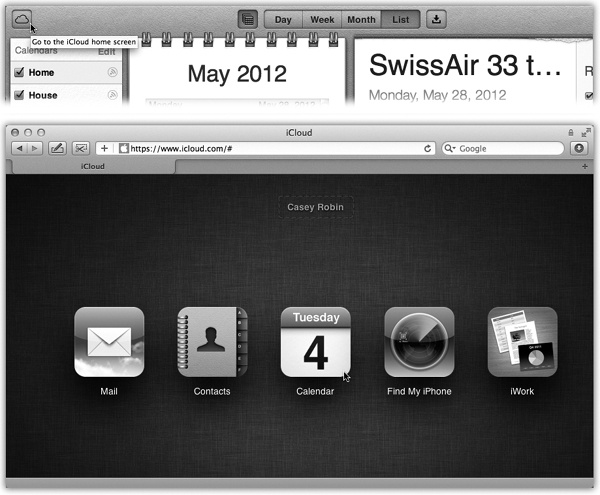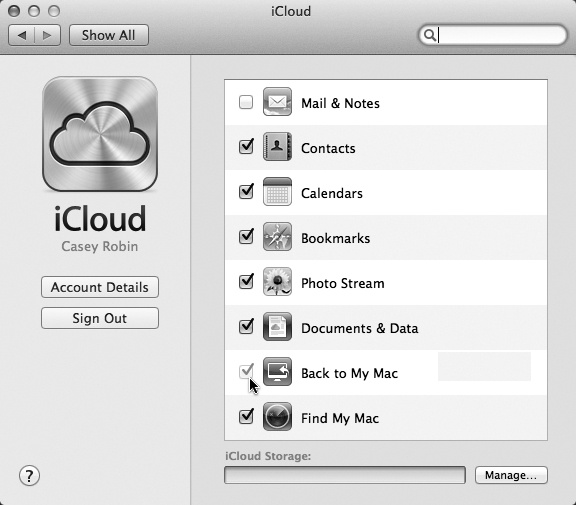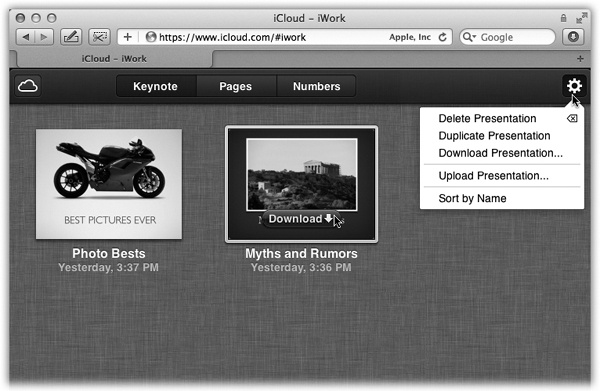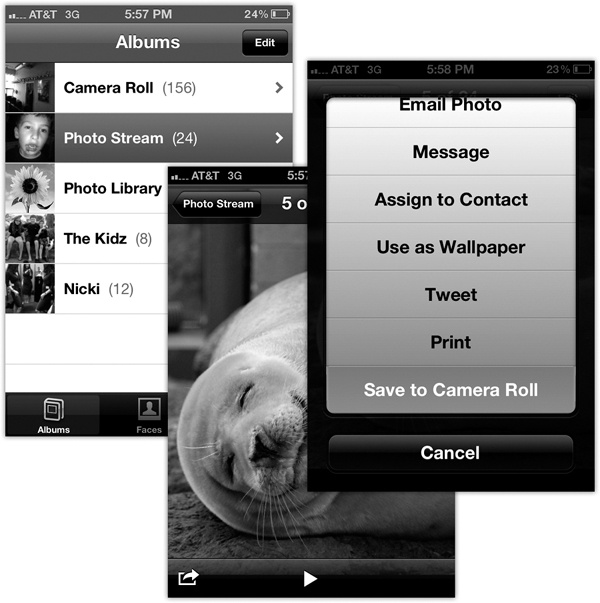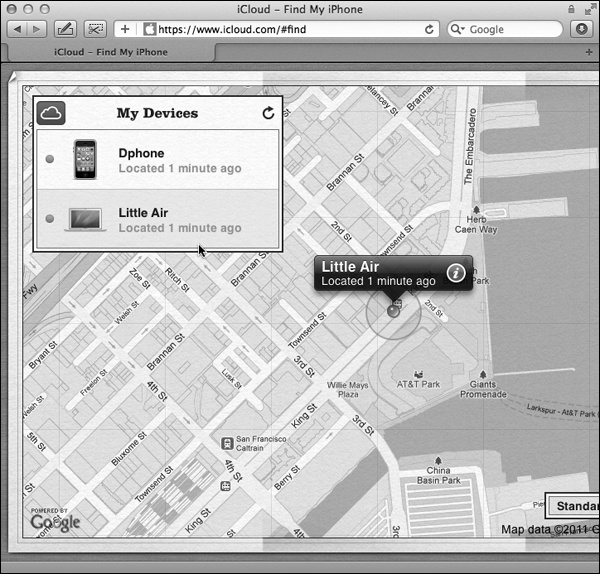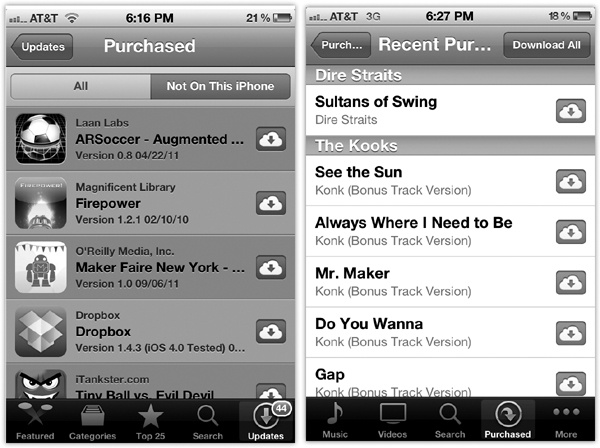Apple’s free iCloud service—formerly MobileMe, formerly .Mac, formerly iTools—offers a long list of very useful features. You don’t have to sign up, but you owe it to yourself to know what’s available.
So what is iCloud? Mainly, it’s these things:
A synchronizing service. It keeps your calendar, address book, and documents updated and identical on all your gadgets: Mac, PC, iPhone, iPad, iPod Touch.
An online locker. Anything you buy from Apple—music, TV shows, ebooks, and apps—is stored online, for easy access at any time. For example, whenever you buy a song or a TV show from the online iTunes store, it appears automatically on all your i-gadgets and computers. Your photos are stored online, too.
Back to My Mac. This option lets you grab files from one of your other Macs across the Internet. See Variations on Screen Sharing.
Find My iPhone—and Mac. Find My iPhone pinpoints the current location of your iPhone or iPad on a map. In other words, it’s great for helping you find your i-gadget if it’s been stolen or lost.
You can also make your lost gadget start making a loud pinging sound for a couple of minutes by remote control—even if it was set to Vibrate mode. That’s brilliantly effective when your phone has slipped under the couch cushions. In dire situations, you can even erase the phone by remote control, preventing sensitive information from falling into the wrong hands.
In iCloud, this feature can find your Mac, too. That might seem like a silly idea; how often do you misplace your iMac? But 75 percent of all computers Apple sells are laptops.
Automatic Backup. iCloud can back up your iPhone, iPad, or iPod Touch—completely, automatically, and wirelessly (over WiFi, not over cellular connections). It’s a quick backup, since iCloud backs up only the changed data.
If you ever want to set up a new i-gadget, or if you want to restore everything to an existing one, life is sweet. Once you’re in a WiFi hot spot, all you have to do is re-enter your Apple ID and password in the setup assistant that appears when you turn the thing on. Magically, your gadget is refilled with everything that used to be on it.
Note
Well, almost everything. You get back everything you’ve bought from Apple (music, apps, books); photos and videos in your Camera Roll; settings, including the layout of your Home screen; text messages; and ringtones. Your mail and anything that came to the gadget from your computer (like music from iTunes and photos from iPhoto) have to be reloaded.
Figure 10-11. To switch among iCloud features, click the ![]() button that always appears in the upper-left
corner of each feature’s screen (like the calendar, shown at top).
That summons the icons for the major iCloud Web-based features:
email, address book, calendar, Find My iPhone (and Macs and iPads
and iPhone Touches), and iWork.
button that always appears in the upper-left
corner of each feature’s screen (like the calendar, shown at top).
That summons the icons for the major iCloud Web-based features:
email, address book, calendar, Find My iPhone (and Macs and iPads
and iPhone Touches), and iWork.
Much of this is based on the central Web site www.icloud.com (Figure 10-11).
iCloud has certain requirements. Your Mac needs Mac OS X 10.7.2 or later, plus iPhoto version 11 or later, and iTunes version 10.5 or later. Your iPhone/iPad/iPod Touch needs iOS 5 or later. On a PC, iCloud requires Windows Vista or later, Outlook 2007 or later, and Apple’s free iCloud Control Panel.
Once you have all of this, your iCloud adventure begins in System Preferences; click the iCloud icon. Enter your Apple ID and password (Tip). Click Sign In.
Now the preference pane invites you to turn on two of the biggest iCloud features:
Use iCloud for contacts, calendars, and bookmarks. It’s hard to imagine that you’d turn off this option—it’s the single most important iCloud feature—but this is the on/off switch if you’re some kind of heretic.
Use Find My Mac. This is the “find my lost laptop on a map” feature described earlier in this chapter. Click Next, and then confirm that you really want to use Find My Mac.
Figure 10-12. The headquarters of iCloud’s features. You’ll find a nearly identical panel on your iPhone, iPad, or iPod Touch (in Settings→iCloud).
At last you arrive at the screen you’ll see when you open the iCloud pane on System Preferences from now on (Figure 10-12).
Let your grand tour of iCloud’s motley features begin.
For many people, this may be the killer app for iCloud right here: The icloud.com Web site, acting as the master control center, can keep multiple Macs, Windows PCs, and iPhones/iPads/iPod Touches synchronized. There’s both a huge convenience factor—all your stuff is always on all your gadgets—and a safety/backup factor, since you have duplicates everywhere.
It works by storing the master copies of your stuff—email, notes, contacts, calendars, Web bookmarks, and documents—on the Web. (Or “in the cloud,” as the product managers would say.)
Whenever your Macs, PCs, or i-gadgets are online, they connect to the mother ship and update themselves. Edit an address on your iPhone, and shortly thereafter, you’ll find the same change in Address Book (on your Mac) and Outlook (on your PC). Send an email reply from your PC at the office and you’ll find it in your Sent Mail folder on the Mac at home. Add a Web bookmark anywhere and find it everywhere else. Edit a spreadsheet in Numbers on your iPad, find the same numbers updated on your Mac.
Actually, there’s another place where you can work with your data: on the Web. At www.icloud.com, you can log in to find Web-based clones of iCal, Address Book, Mail, and iWork.
To set up syncing, open System Preferences→iCloud. Turn on the checkboxes of the stuff you want to be synchronized all the way around:
Mail & Notes. Mail refers to your actual email messages, plus your account settings and preferences from Mac OS X’s Mail program. Notes refers to the notes you enter in Mail’s Notes feature (Chapter 11). How great to make a reminder for yourself on one Mac and have it reminding you later on another one.
Calendars, Contacts. This is a big one. There’s nothing as exasperating as realizing that the Address Book you’re consulting on your home Mac is missing somebody you’re sure you entered—on your computer at work. This option keeps all your Macs’ Address Books and iCal calendars synchronized. Delete a phone number at work, and you’ll find it deleted on your Mac at home, too. Enter an appointment on your iPhone, and you’ll find the calendar updated everywhere else.
Bookmarks. If a Web site is important enough to merit bookmarking while you’re using your laptop, why shouldn’t it also show up in the Bookmarks menu on your desktop Mac at home, your iPhone, or your PC at work? This option syncs your Safari Reading List, too.
Photo Stream. See Photo Stream.
Documents and Data. Some programs are available for more than one machine—including Apple’s own iWork suite (Numbers, Pages, Keynote). Those programs are available for Mac, iPhone/iPod Touch, and iPad.
In that delicious situation, you can create or edit a document on one kind of machine, and marvel as iCloud automatically syncs it with all your other devices.
When you fire up one of the iWork programs on an i-gadget, the startup screen offers two buttons: Later (don’t connect to iCloud now) or Use iCloud (copy your work wirelessly to iCloud, so your other computers and gadgets can get at it).
From now on, you don’t have to do anything special; any document you create or edit appears automatically on your other iCloud-connected machines. If you have iWork for your Mac, your documents are auto-synced to iCloud if you’ve turned on this checkbox in System Preferences.
Figure 10-13. To see the documents your i-gadgets have stored online, log into iCloud.com. Click the
 icon, if necessary, and switch to the
iWork mode. To download one of your mobilely created
files, point to its icon and click Download. To upload files
from your Mac to your mobile gadgets,
drag them into this window from the Finder, or choose Upload
from the
icon, if necessary, and switch to the
iWork mode. To download one of your mobilely created
files, point to its icon and click Download. To upload files
from your Mac to your mobile gadgets,
drag them into this window from the Finder, or choose Upload
from the  menu.
menu.On your computer, though, the syncing isn’t quite so automatic; you’re supposed to use the iWork page of iCloud.com to upload and download Keynote, Numbers, and Pages files to and from your mobile gadgets. See Figure 10-13.
Back to My Mac. See Variations on Screen Sharing for details.
Find My Mac. Read on.
To set up syncing, turn on the checkboxes for the items you want synced.
Note
You may notice that there are no checkboxes here for syncing stuff you buy from Apple, like books, movies, apps, and music. They’re not so much synced as they are stored for you online. You can download them at any time to any of your machines.
After the first sync with the first machine, you can turn on the checkboxes on the other computers and gadgets, too, in effect telling them to participate in the great data-sharing experiment.
Every time a new photo enters your life—when you take a picture with an i-gadget, for example, or import one onto your computer—it gets added to your Photo Stream. In other words, it appears automatically on all your other iCloud machines. Here’s where to find them:
iPhone, iPad, iPod Touch. Open your Photos app. There it is: a new listing called Photo Stream. It shows the most recent 1,000 photos you’ve taken with any of your other i-gadgets, or that you’ve imported to your computer from a scanner or digital camera.
Now, Apple realizes that your i-gadget doesn’t have nearly as much space available as your Mac or PC; you can’t yet buy an iPad with 750 gigabytes of storage. That’s why, on your iPhone/iPad/iPod, your Photo Stream consists of just the last 1,000 photos. (There’s another limitation, too: The iCloud servers store your photos for 30 days. As long as your gadgets go online at least once a month, they’ll remain current with the photo stream.)
Figure 10-14. Left: Why, look! It’s photos you imported onto your Mac at home. How’d they get here on the iPhone? iCloud! Middle: To rescue one of these photos from the 1,000-Photo Rule, open it. Then tap the
 button. Right: Finally, tap Save
to Camera Roll. Now, even after that photo disappears from the
Photo Stream, having been displaced by the 1,001st incoming
photo, you’ll still have your permanent copy.
button. Right: Finally, tap Save
to Camera Roll. Now, even after that photo disappears from the
Photo Stream, having been displaced by the 1,001st incoming
photo, you’ll still have your permanent copy.Once a photo arrives, you can save it to your Camera Roll, where it’s permanently saved. See Figure 10-14.
On the Mac or PC. In iPhoto (Mac), your Photo Stream photos appear in a new album called, of course, Photo Stream. On a Windows PC, you get a Photo Stream folder in your Pictures folder.
You don’t have to worry about that 30-day, 1,000-photo business. Once pictures appear here, they’re here until you delete them.
This, in its way, is one of the best features in all of iCloudland, because it means you don’t have to sync your iPhone over a USB cable to get your photos onto your computer. It all happens automatically, wirelessly over WiFi.
Apple TV. When you’re viewing your photos on an Apple TV, a new album appears there called Photo Stream. There they are, ready for showing on the big plasma.
If you bought your gadget/photo software/Apple TV before iCloud’s debut, of course, you’ll need a software update to add the Photo Stream feature.
Did your laptop get stolen? Did you leave your iPhone somewhere? Has that mischievous 5-year-old hidden your iPad again?
Now you can check into iCloud.com to see exactly where your Mac, iPhone, or iPad is. You can even make it beep loudly for 2 minutes, so you can figure out which couch cushion it’s under, or which jacket pocket you left it in. If the missing item is an iPad or an iPhone, you can make it beep even if the ringer switch is off, and even if the phone is asleep. You can also make a message pop up on the screen; if you actually left the thing in a taxi or on some restaurant table, you can use this feature to plead for its return. The bottom line: If you ever lose your Apple gear, you have a fighting chance at getting it back.
(That’s if it’s online, and if you turned on Find My Mac in the iCloud panel of System Preferences.)
If an ethical person finds your phone, you might get it back. If it’s a greedy person who says, “Hey, cool! A free iPhone!” then maybe you can bombard him with so many of these messages that he gives it back in exasperation.
If not, you can either lock the gadget with a password (yes, by remote control) or even avail yourself of one more amazing last-ditch feature: Remote Wipe.
That means erasing your data by remote control, from wherever you happen to be. The evil thief can do nothing but stare in amazement as the phone, tablet, or Mac suddenly erases itself, winding up completely empty.
(If you ever get the device back, you can just sync with iTunes, and presto! Your stuff is back—at least everything since your last sync.)
To set up your Mac so you can find it remotely, open System Preferences→iCloud. Make sure Find My Mac is turned on. That’s all there is to it.
Later, if the worst should come to pass and you can’t find your Mac, go to any computer and call up www.icloud.com. Log in with your Apple name and password.
Click the ![]() icon at upper left; in the list of iCloud
features, click Find My iPhone. If you’re asked for your password
again, type it; Apple wants to make sure it’s really,
really you who’s messing around with your
account settings.
icon at upper left; in the list of iCloud
features, click Find My iPhone. If you’re asked for your password
again, type it; Apple wants to make sure it’s really,
really you who’s messing around with your
account settings.
Finally, in the panel on the left side, click the name of your Mac.
Immediately, the Web site updates to show you, on a map, the current location of your Macs (and iPhones, iPod Touches, and iPads); see Figure 10-15.
Figure 10-15. The location process can take a couple of minutes. You can zoom into or out of the map, click Satellite to see an overhead photo of the area, or click Hybrid to see the photo with street names superimposed.
Note
If they’re not online, or if they’re turned all the way off, you won’t see their current locations. If your Mac is asleep, you won’t find it, although if your i-gadget is asleep, you will.
If just knowing where the thing is isn’t enough to satisfy you, click the little pushpin that represents your Mac, and try one of these three buttons:
Display Message or Play Sound. Click this button, type a message, and then click Send. Instantly, that message appears on the Mac’s screen, wherever it is, no matter what app was running. Whoever’s using it can’t miss it, can’t even do anything without dismissing the message.
When it’s all over, Apple sends an email confirmation to your @me.com address.
Lock. What if you worry about the security of your Mac’s info, but you don’t want to erase it completely and just want to throw a low-level veil of casual protection over the thing? Easy: Lock it by remote control. The Lock button lets you make up a four-digit passcode. Without it, the sleazy crook can’t get into your Mac without erasing it.
Remote Wipe. This is the last-ditch security option, for when your immediate concern isn’t so much the Mac as all the private stuff that’s on it. Click this button, confirm the dire warning box, and click Erase All Data. By remote control, you’ve just erased everything from your Mac, wherever it may be. (If it’s ever returned, you can restore it from your Time Machine backup.)
Once you’ve wiped the Mac, you can no longer find it or send messages to it using Find My Mac.
Apple offers an email address as part of each iCloud account. Of course, you already have an email account. So why bother? The first advantage is the simple address: [email protected].
Second, me.com addresses are integrated into Mac OS X’s Mail program, as you’ll see in the next chapter. And, finally, you can read your me.com email from any computer anywhere in the world, via the iCloud.com Web site, or on your iPhone/iPod Touch/iPad.
To make things even sweeter, your me.com mail is completely synced. Delete a message on one gadget, and you’ll find it in the Deleted Mail folder on another. Send a message from your iPad, and you’ll find it in the Sent Mail folder on your Mac. And so on.
Apple, as if you hadn’t noticed, has become a big seller of multimedia files. It has the biggest music store in the world. It has the biggest app store, for both i-gadgets and Macs. It sells an awful lot of TV shows and movies. Its ebook store, iBooks, is no Amazon.com, but it’s chugging along.
When you buy a song, movie, app, or book, you’ve always been allowed to copy it to all your other Apple equipment—no extra charge. But iCloud automates, or at least formalizes, that process. Once you buy something, it’s added to a tidy list of items that you can download to all your other machines.
Figure 10-16. Anything you’ve bought from Apple, like apps (left), music (right), TV shows, and ebooks, is always available to you, from any Mac or i-gadget, for redownloading from the great Apple locker in the sky. Tap the cloud-with-arrow button to download something to the machine you’re using now.
Here’s how to grab them:
iPhone, iPad, iPod Touch. Open the App Store icon (for apps), the iBooks program (for books), or the iTunes app (for songs or TV shows; tap the category you want). Tap Updates. Tap Purchased. Tap Not on My iPhone (see Figure 10-16).
There they are: all the items you’ve bought on your other machines using the same Apple ID. To download anything listed here onto this machine, tap the
 button. Or tap an album name to see the
list of songs on it so you can download just
some of those songs.
button. Or tap an album name to see the
list of songs on it so you can download just
some of those songs.You can save yourself all that tapping by opening Settings→Store and turning the Automatic Downloads switches to On (for Music, Apps, and Books). From now on, whenever you’re in WiFi, stuff you’ve bought on other Apple machines gets downloaded to this one automatically, in the background.
Mac or PC. Open the App Store program (for apps) or the iTunes app (for songs, TV shows, books, and movies). Under the Store heading, there they are: individual subheadings for each gadget you’ve used to buy stuff: “Purchased on iPhone,” “Purchased on Mom’s iPad,” and so on. Or just click Purchased to view the entire list. There are all your purchases, ready to open or redownload if necessary.

